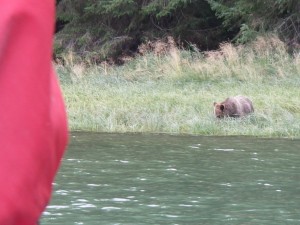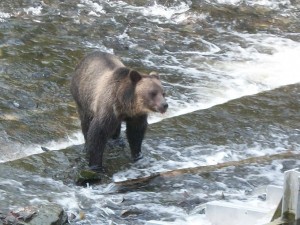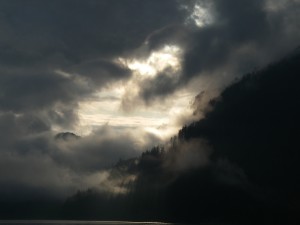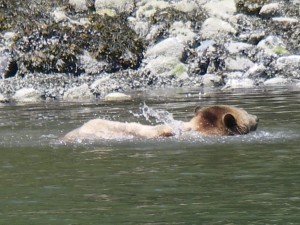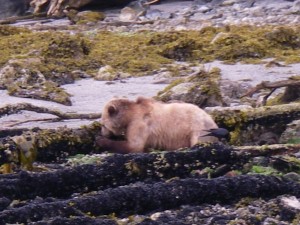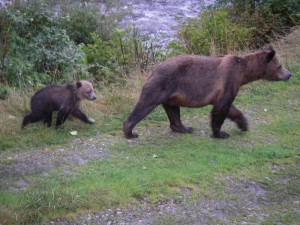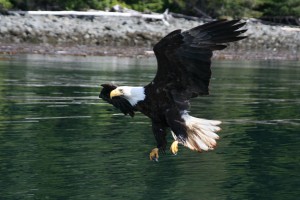Grizzly Watching
Grizzly Bears are magnificent and the biggest reason visitors choose our lodge!
Grizzly bears thrive here and the viewing opportunities are spectacular. We have operated our Grizzly Bear Lodge for decades and know the prime spots for bear watching. The ultimate grizzly bear photo opportunities.
Viewing grizzly bears from the stands
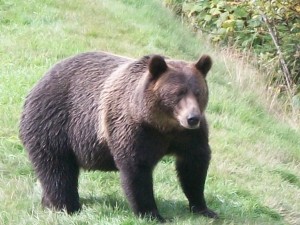
The grizzly bear tour from the lodge travels up Knight Inlet to the viewing stands on the Glendale River. It is estimated that there are close to fifty bears in the Glendale River valley and they come to this area to feed on the pink salmon that arrive in late August and travel up the rive to the man made spawning channel. The viewing stands overlook this spawning area and the grizzly bears come to fish, eat and fatten up for their winter hibernation. If one was to attract human attributes to the grizzly one might speculate that this bear was thinking “If I close my eyes maybe these humans will be gone when I open them.” or “If I can’t see them they can’t see me.” All in all the bears are very tolerant of our presence and we are ignored unless someone forgets to turn off their camera flash, makes a load noise or sudden movements. Just pretend you child or grandchild has just gone to sleep and you do not want to wake them, talk quietly and move slowly.
Grizzly bear claw surgery
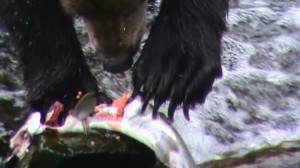
A grizzly bear’s normal claw length is 3 to 4 inches long; it is curved and the sharp claws helps it to dig for its food. In early spring the bears use these claws to dig up the root bulb of the skunk cabbage, one of their favourite foods. As the season progresses the claws allow grizzlies to get a good hold on the beach rock they turn over in search of crab, clams, amphipods and other tiny invertebrates. Claws are also used to scrape mussels and barnacles off the beach logs and rocks. And as this photo, by UK’s Janis Worsley, shows the claws permit the bears to hold the salmon in position while also opening the belly to expose the fat rich eggs. Views such as this are common in the fall as viewing takes place from the stands on Knight Inlet’s Glendale River. The stands overlook the spawning channel and tens of thousands of pink salmon that come to spawn. It is a grizzly bear buffet and the main and only course is salmon.
Mystic morning in Knight Inlet
I love running up Knight Inlet in the morning as every morning offers something special and this was one I really liked. The run up the inlet to where we watch the grizzly bears is just over an hour and this photo was taken at the start on the run and was special for two reasons. First that I like clouds and cloud formations especially with the dark cover and the sun starting to show through. Second that sun was shinning on the valley that contained the Glendale River which was our destination so I knew we had a great day ahead.
Fast deer win
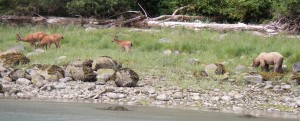
Grizzly bears are omnivores (everything-eaters) because they eat a variety of plant and animal foods and tend to be opportunity feeders. On the coast of BC, beginning in the spring, the bears feed on early green vegetation such as skunk cabbage and sedges located in the estuaries and that appear first. Bears access the food in the inter-tidal waters at low tides to and their great sense of smell helps them locate carrion. Even thought grizzly bears can run in an excess of 30 mph about the same as white-tailed deer they are not quite as agile. The deer keep a comfort zone between themselves and the bears while the bear’s weight the energy required to possibly catch the deer with the chance of success and rarely give case.
Grizzly Cooling off
Yes it is safe to viewing grizzly bears from boats. We travel up Knight Inlet from Grizzly Bear Lodge to the Glendale River and transfer to a sixteen foot flat bottom skiff to make the bear watching easier, however the boat is still faster than a swimming grizzly. This July grizzly is cooling off and enjoying a swim along the shore. From the amount of its body above the water line it has already put on a good deal of fat just eating the sedge grass along the shore as well as Turing over rocks at low tide. The abundance of berries at this time of the year are also a help ad they wait for the salmon to return to the river.
Follow the birds
Everyone benefits when grizzly bears come to the beach at low tide. This bear is having a meal of mussels it scrapes off the logs. Any bits and pieces the bear leaves provide an easy meal for the crows, which are always close. Turning over rocks also uncovers many sand fleas and lice that the bears may overlook but not the crows.
Grizzly bear cub copies mothers walk
This photo from late August with a mother grizzly and cub in synchronized walking was taken at the viewing stands on Knight Inlet’s Glendale River. The lodge is permitted on the stands after August 24th each year. This is timed to be several weeks after the spawning salmon have arrived in the river and gives the bears time to return to the area to fish. By looking at the lack of belly on this female grizzly she and her cub need to put on allot of fat if they are going to survive the winter. A grizzly will lose up to 40% of its body fat during hibernation so they must start with extra fat to survive.
Eagle eye
A great bald eagle picture provided by Glen one of the lodge’s guides. Some guests manage to obtain good “diving” eagle pictures but Glen seems to have the edge. As is the case with most wildlife photography – “opportunity, opportunity, opportunity”. The more time one is able to spend taking picture the more likely that there will be a great one. I am not belittling Glen’s success, as that is his own philosophy. I keep say that it is only partially true one need an “eye” for composition and Glen definitely has the “eye”.
Grizzly Bear viewing close up
